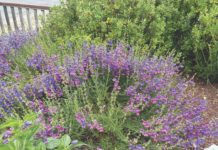Despite Santa Cruz County’s ocean breezes and mountain air, the itchy eyes, sneezing and stuffy noses caused by seasonal allergies are commonplace between January and July along the coast and among the redwoods of the San Lorenzo Valley.
One might suppose the nearby ocean would keep the air fresh and allergen free. But wind patterns in Santa Cruz County blow pollen from trees and grass willy-nilly into almost every nook and cranny.
Dr. James Wolfe, an associate with Allergy and Asthma Associates of Northern California, said that, like clockwork, allergies strike in the spring and summer.
“Every year January through May when it’s not raining, trees pollinate heavily in Santa Cruz County,” Wolfe said.
Wolfe said most people think the bright yellow flowering acacia trees are the root of the problem. However, other trees, many without flowers, cause stronger allergic reactions.
From January to March, juniper and cedar trees release their pollen into the air. In April, oak trees pollinate heavily, and in May, olive trees release their nearly microscopic pollen, Wolfe said.
Other trees, such as birch, alder, ash and mulberry, can create problems for some people, too.
Then in May, June and July, Wolfe said, wild grasses found throughout the county release more pollen, causing three more months of anguish for many.
“People who are not affected think allergies — runny noses, and itchy eyes — are not a big deal,” Wolfe said. “Little do they know that when you walk around all day with these things, you are exhausted. It lowers the quality of life.”
Dr. Steve Magee, a family practitioner at Boulder Creek Family Practice said that along with the typical allergens, he sees people allergic to redwood trees which are common in the San Lorenzo Valley.
“Most of the time, the treatment is the same (as other seasonal allergies),” Magee said.
Hay fever is the common term used to describe allergies that cause such symptoms.
According to statistics gathered by the Centers for Disease Control and Prevention, 16.9 million Americans, including 6.7 million children, were told by doctors that they were afflicted with hay fever in the past 12 months. Hay fever is caused by indoor or outdoor pollens, pet dander or dust mites.
“We have patients knocking down our door right now trying to put an end to misery they have experienced year after year,” Wolfe said.
Magee also said that springtime is prime allergy season as he sees patients suffering from allergies almost daily.
But Wolfe said treating allergies is easier than it once was, as over-the-counter medication is improving.
Loratidine, sold under the brand name Claritin, and Fexofenadine, sold as Allegra, are both sold at drugstores without a prescription. Wolfe said they relieve hay fever symptoms without making people tired the way older medications did.
If those options don’t work, Wolfe recommends intranasal steroids. Then, if symptoms persist, people can have their skin tested to determine exactly what they are allergic to and receive shots to battle the allergies.
“There are definitely some effective treatments available,” Magee said.
To comment, email editor Peter Burke at pe***@*********er.com, call 438-2500 or post a comment at www.pressbanner.com.











